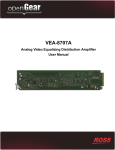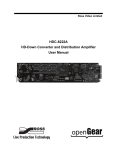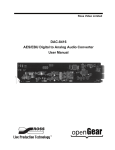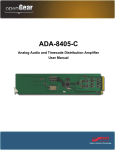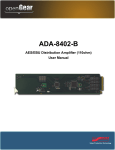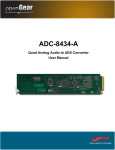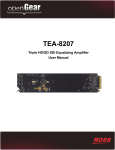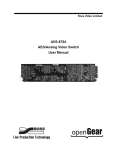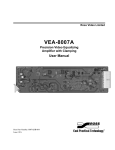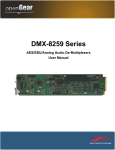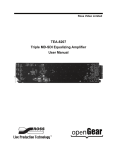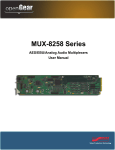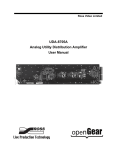Download VEA_8707A User Manual
Transcript
Ross Video Limited VEA-8707A Analog Video Equalizing Distribution Amplifier User Manual VEA-8707A • Analog Video Equalizing Distribution Amplifier User Manual • Ross Part Number: 8707ADR-004-01 • Release Date: January 25, 2010. Printed in Canada. The information contained in this manual is subject to change without notice or obligation. Copyright © 2010 Ross Video Limited. All rights reserved. Contents of this publication may not be reproduced in any form without the written permission of Ross Video Limited. Reproduction or reverse engineering of copyrighted software is prohibited. Patents This product is protected by the following US Patents: 4,205,346; 5,115,314; 5,280,346; 5,561,404; 7,034,886; 7,508,455. This product is protected by the following Canadian Patents: 2039277; 1237518; 1127289. Other patents pending. Notice The material in this manual is furnished for informational use only. It is subject to change without notice and should not be construed as commitment by Ross Video Limited. Ross Video Limited assumes no responsibility or liability for errors or inaccuracies that may appear in this manual. Trademarks • • is a registered trademark of Ross Video Limited. is a trademark of Ross Video Limited. • Ross, ROSS, ROSS® are registered trademarks of Ross Video Limited. • DashBoard Control System™ is a trademark of Ross Video Limited. • All other product names and any registered and unregistered trademarks mentioned in this guide are used for identification purposes only and remain the exclusive property of their respective owners. Important Regulatory and Safety Notices Before using this product and any associated equipment, refer to the “Important Safety Instructions” listed below to avoid personnel injury and to prevent product damage. Products may require specific equipment, and/or installation procedures to be carried out to satisfy certain regulatory compliance requirements. Notices have been included in this publication to call attention to these specific requirements. Symbol Meanings This symbol on the equipment refers you to important operating and maintenance (servicing) instructions within the Product Manual Documentation. Failure to heed this information may present a major risk of damage or injury to persons or equipment. Warning — The symbol with the word “Warning” within the equipment manual indicates a potentially hazardous situation which, if not avoided, could result in death or serious injury. Caution — The symbol with the word “Caution” within the equipment manual indicates a potentially hazardous situation which, if not avoided, may result in minor or moderate injury. It may also be used to alert against unsafe practices. Notice — The symbol with the word “Notice” within the equipment manual indicates a situation, which if not avoided, may result in major or minor equipment damage or a situation which could place the equipment in a non-compliant operating state. ESD Susceptibility — This symbol is used to alert the user that an electrical or electronic device or assembly is susceptible to damage from an ESD event. Important Safety Instructions Caution — This product is intended to be a component product of the DFR-8300 series frame. Refer to the DFR-8300 series frame User Manual for important safety instructions regarding the proper installation and safe operation of the frame as well as its component products. Warning — Certain parts of this equipment namely the power supply area still present a safety hazard, with the power switch in the OFF position. To avoid electrical shock, disconnect all A/C power cards from the chassis’ rear appliance connectors before servicing this area. Warning — Service barriers within this product are intended to protect the operator and service personnel from hazardous voltages. For continued safety, replace all barriers after any servicing. This product contains safety critical parts, which if incorrectly replaced may present a risk of fire or electrical shock. Components contained with the product’s power supplies and power supply area, are not intended to be customer serviced and should be returned to the factory for repair. To reduce the risk of fire, replacement fuses must be the same time and rating. Only use attachments/accessories specified by the manufacturer. EMC Notices United States of America FCC Part 15 This equipment has been tested and found to comply with the limits for a class A Digital device, pursuant to part 15 of the FCC Rules. These limits are designed to provide reasonable protection against harmful interference when the equipment is operated in a commercial environment. This equipment generates, uses, and can radiate radio frequency energy and, if not installed and used in accordance with the instruction manual, may cause harmful interference to radio communications. Operation of this equipment in a residential area is likely to cause harmful interference in which case the user will be required to correct the interference at his own expense. Notice — Changes or modifications to this equipment not expressly approved by Ross Video Limited could void the user’s authority to operate this equipment. CANADA This Class “A” digital apparatus complies with Canadian ICES-003. Cet appariel numerique de la classe “A” est conforme a la norme NMB-003 du Canada. EUROPE This equipment is in compliance with the essential requirements and other relevant provisions of CE Directive 93/68/EEC. INTERNATIONAL This equipment has been tested to CISPR 22:1997 along with amendments A1:2000 and A2:2002, and found to comply with the limits for a Class A Digital device. Notice — This is a Class A product. In domestic environments, this product may cause radio interference, in which case the user may have to take adequate measures. Maintenance/User Serviceable Parts Routine maintenance to this openGear product is not required. This product contains no user serviceable parts. If the module does not appear to be working properly, please contact Technical Support using the numbers listed under the “Contact Us” section on the last page of this manual. All openGear products are covered by a generous 5-year warranty and will be repaired without charge for materials or labor within this period. See the “Warranty and Repair Policy” section in this manual for details. Environmental Information The equipment that you purchased required the extraction and use of natural resources for its production. It may contain hazardous substances that could impact health and the environment. To avoid the potential release of those substances into the environment and to diminish the need for the extraction of natural resources, Ross Video encourages you to use the appropriate take-back systems. These systems will reuse or recycle most of the materials from your end-of-life equipment in an environmentally friendly and health conscious manner. The crossed-out wheeled bin symbol invites you to use these systems. If you need more information on the collection, reuse, and recycling systems, please contact your local or regional waste administration. You can also contact Ross Video for more information on the environmental performances of our products. Company Address Ross Video Limited Ross Video Incorporated 8 John Street Iroquois, Ontario Canada, K0E 1K0 P.O. Box 880 Ogdensburg, New York USA 13669-0880 General Business Office: (+1) 613 • 652 • 4886 Fax: (+1) 613 • 652 • 4425 Technical Support: (+1) 613 • 652 • 4886 After Hours Emergency: (+1) 613 • 349 • 0006 E-mail (Technical Support): [email protected] E-mail (General Information): [email protected] Website: http://www.rossvideo.com Contents Introduction 1 Overview.............................................................................................................................. 1-2 Features.................................................................................................................. 1-2 Functional Block Diagrams ................................................................................................. 1-3 Documentation Terms and Conventions.............................................................................. 1-4 Installation 2 Before You Begin ................................................................................................................ 2-2 Static Discharge..................................................................................................... 2-2 Unpacking.............................................................................................................. 2-2 Installing the VEA-8707A ................................................................................................... 2-3 Rear Modules for the VEA-8707A........................................................................ 2-3 Installing a Rear Module ....................................................................................... 2-3 Installing the VEA-8707A..................................................................................... 2-4 Cabling for the VEA-8707A................................................................................................ 2-5 DFR-8310 Series Frame Cabling Overview.......................................................... 2-5 DFR-8321 Series Frame Cabling Overview.......................................................... 2-5 Software Upgrades for the VEA-8707A.............................................................................. 2-7 Performing Software Upgrades ............................................................................. 2-7 User Controls 3 Card Overview ..................................................................................................................... 3-2 Control and Monitoring Features......................................................................................... 3-4 Status and Selection LEDs on the VEA-8707A .................................................... 3-4 Notes on Clamping .............................................................................................................. 3-6 Clamping Speed and Time .................................................................................... 3-6 Menus 4 SNMP Monitoring and Control ........................................................................................... 4-2 DashBoard Menus for the VEA-8707A............................................................................... 4-3 Status Tabs ............................................................................................................ 4-3 Setup Menus .......................................................................................................... 4-4 Specifications 5 VEA-8707A Technical Specifications................................................................................. 5-2 Service Information 6 Troubleshooting Checklist ................................................................................................... 6-2 Bootload Button .................................................................................................... 6-2 Warranty and Repair Policy................................................................................................. 6-3 VEA-8707A User Manual (Iss. 01) Contents • i ii • Contents VEA-8707A User Manual (Iss. 01) Introduction In This Chapter This chapter contains the following sections: • Overview • Functional Block Diagrams • Documentation Terms and Conventions A Word of Thanks Congratulations on choosing an openGear VEA-8707A Analog Video Equalizing Distribution Amplifier. Your VEA-8707A is part of a full line of Digital Products within the openGear Terminal Equipment family of products, backed by Ross Video's experience in engineering and design expertise since 1974. You will be pleased at how easily your new VEA-8707A fits into your overall working environment. Equally pleasing is the product quality, reliability and functionality. Thank you for joining the group of worldwide satisfied Ross Video customers! Should you have a question pertaining to the installation or operation of your VEA-8707A, please contact us at the numbers listed on the back cover of this manual. Our technical support staff is always available for consultation, training, or service. VEA-8707A User Manual (Iss. 01) Introduction • 1–1 Overview The VEA-8707A Precision Video Equalizing Amplifier with Clamping precisely and easily equalizes your choice of three popular coaxial cable types: Belden 8281, 1694, or 1505A. This 3-cable type selection ability is achieved to a level of accuracy never before obtained in a single amplifier. All other amplifiers on the market are designed primarily for one type of cable and usually achieve mediocre results with other cable types, or require complex and time-consuming adjustment procedures. During installation, the setting of a single adjustment is all that is needed to obtain unparalleled equalization accuracy, thanks to very accurate factory-calibration. The need to use elaborate frequency response measuring equipment in the field is eliminated. Back porch clamping is provided to assist in the removal of hum or other signal disturbances. Two clamping speeds are jumper selectable. A differential input gives excellent ground loop rejection. The amplifier input may be AC or DC coupled. Temperature drift effects are almost non-existent due to the use of the latest in analog ASIC’s combined with meticulous product engineering. The power to each VEA-8707A is individually fused to prevent failure of any one card from affecting the rest of the cards in the frame. Features The following features make the VEA-8707A the best solution for general analog equalizing: 1–2 • Introduction • Precision equalization of 3 selectable coaxial cable types up to 1,000ft (305m) • Easy single-control equalization for fast installation • AC or DC input coupling • Back porch clamping • Supports Tri-Level Sync distribution • Delay matched for precise inter-changeability\ • Superb stability of frequency response • Differential input for outstanding ground loop hum rejection • Excellent isolation between outputs • Reports status and configuration remotely via the DashBoard Control System™ • Fits DFR-8300 series frames • Fully compliant with openGear specifications • 5-year transferable warranty VEA-8707A User Manual (Iss. 01) Functional Block Diagrams This section provides functional block diagrams that outline the workflow of the VEA-8707A. Figure 1.1 VEA-8707A without Looping — Simplified Block Diagram Figure 1.2 VEA-8707A with Looping — Simplified Block Diagram VEA-8707A User Manual (Iss. 01) Introduction • 1–3 Documentation Terms and Conventions The following terms and conventions are used throughout this manual: 1–4 • Introduction • “Frame” refers to DFR-8300 series frame that houses the VEA-8707A card, as well as any openGear frames. • All references to the DFR-8300 series frame also includes all version of the 10-slot (DFR-8310 series) and 20-slot (DFR-8321 series) frames and any available options unless otherwise noted. • All references to the VEA-8707A also includes all versions unless otherwise indicated. • “Operator” and “User” refer to the person who uses VEA-8707A. • “Board”, and “Card” refer to openGear terminal devices within openGear frames, including all components and switches. • “System” and “Video system” refer to the mix of interconnected production and terminal equipment in your environment. • “525-line mode” refers to broadcast situations using NTSC composite (analog) signal reference inputs. • “625-line mode” refers to broadcast situations using PAL-B or PAL-G composite (analog) signal reference inputs. • “PAL” refers to PAL-B, and PAL-G unless otherwise stated. • The “Operating Tips” and “Note” boxes are used throughout this manual to provide additional user information. VEA-8707A User Manual (Iss. 01) Installation In This Chapter This chapter provides instructions for installing the Rear Module(s) for the VEA-8707A, installing the card into the frame, cabling details, and updating the card software. The following topics are discussed: • Before You Begin • Installing the VEA-8707A • Cabling for the VEA-8707A • Software Upgrades for the VEA-8707A VEA-8707A User Manual (Iss. 01) Installation • 2–1 Before You Begin Before proceeding with the instructions in this chapter, ensure that your DFR-8300 series frame is properly installed according to the instructions in the DFR-8300 Series User Manual. Static Discharge Throughout this chapter, please heed the following cautionary note: ESD Susceptibility — Static discharge can cause serious damage to sensitive semiconductor devices. Avoid handling circuit boards in high static environments such as carpeted areas and when synthetic fiber clothing is worn. Always exercise proper grounding precautions when working on circuit boards and related equipment. Unpacking Unpack each VEA-8707A you received from the shipping container and ensure that all items are included. If any items are missing or damaged, contact your sales representative or Ross Video directly. 2–2 • Installation VEA-8707A User Manual (Iss. 01) Installing the VEA-8707A This section outlines how to install a Rear Module in a DFR-8300 series frame. The same procedure applies regardless of the frame or rear module type. Rear Modules for the VEA-8707A The Rear Module for the VEA-8707A depends on the openGear frame you are installing the card into. DFR-8310 Series Frames Use one of the following rear modules when installing the card in a DFR-8310 series frame: • 8310AR-030 Rear Module (R1-8707) — Use this rear module if you do not want the looping feature. Note that the 8310AR-030 has the symbol “A” in the top left corner of the module face. • 8310AR-032 Rear Module (R1L-8707) — Use this rear module to access the looping feature. Note that the 8310AR-032 module has the symbol “K” in the top left corner of the module face. If the input is looped on the rear module to another device, JP8 must be set to LOOP. If looping is not used, either set JP8 to TERM, or terminate the input externally at BNC 2. • The VEA-8707A is also compatible with the DFR-8310-BNC frames but this will not support the looping feature. DFR-8321 Series Frames Use one of the following rear modules when installing the card in a DFR-8321 series frames: • 8320AR-30 Full Rear Module (R2-8707) — Use this rear module if you do not want the looping feature. Note that the 8320AR-030 has the symbol “A” in the top left corner of the module face. • 8320AR-032 Full Rear Module (R2L-8707) — Use this rear module to access the looping feature. Note that the 8320AR-032 module has the symbol “K” in the top left corner of the module face. If the input is looped on the rear module to another device, JP8 must be set to LOOP. If looping is not used, either set JP8 to TERM, or terminate the input externally at BNC 2. • 8320AR-031 Split Rear Module (R2S-8707) — Use this rear module to densely populate your frame. Because the looping feature is not available when using this rear module, ensure that the input for each card is terminated on the card by setting JP8 to TERM. Installing a Rear Module If you are installing the VEA-8707A in a DFR-8310-BNC frame, or the Rear Module is already installed, proceed to the section “Installing the VEA-8707A” on page 2-4. Use the following procedure to install a Rear Module in your DFR-8300 series frame: 1. Locate the card frame slots on the rear of the frame. 2. Remove the Blank Plate from the slot you have chosen for the VEA-8707A installation. 3. Install the bottom of the Rear Module in the Module Seating Slot at the base of the frame’s back plane. (Figure 2.1) VEA-8707A User Manual (Iss. 01) Installation • 2–3 Screw Hole Module Seating Slot Figure 2.1 Rear Module Installation in a DFR-8310 Series Frame (VEA-8707A not shown) 4. Align the top hole of the Rear Module with the screw on the top-edge of the frame back plane. 5. Using a Phillips screwdriver and the supplied screw, fasten the Rear Module to the back plane of the frame. Do not over tighten. 6. Ensure proper frame cooling and ventilation by having all rear frame slots covered with Rear Modules or Blank Plates. This completes the procedure for installing a Rear Module in your DFR-8300 series frame. Installing the VEA-8707A This section outlines how to install the VEA-8707A in a DFR-8300 series frame. Use the following procedure to install the VEA-8707A in a DFR-8300 series frame: 1. Locate the Rear Module you installed in the procedure “Installing a Rear Module” on page 2-3. Notice — Heat and power distribution requirements within a frame may dictate specific slot placements of cards. Cards with many heat-producing components should be arranged to avoid areas of excess heat build-up, particularly in frames using convectional cooling. 2. Hold the VEA-8707A by the edges and carefully align the card-edges with the slots in the frame. 3. Fully insert the card into the frame until the rear connection plugs are properly seated in the Rear Module. 4. Affix the supplied Rear Module Label to the BNC area of the Rear Module. This completes the procedure for installing the VEA-8707A in a DFR-8300 series frame. 2–4 • Installation VEA-8707A User Manual (Iss. 01) Cabling for the VEA-8707A This section provides information for connecting cables to the installed Rear Modules on the DFR-8300 series frames. Connect the input and output cables according to the following sections. DFR-8310 Series Frame Cabling Overview In the DFR-8310 series frames, the VEA-8707A is used with the following Rear Modules: • 8310AR-030 (R1-8707) Rear Module — Each card occupies one slot and provides eight analog video outputs, and an analog video input. The input must be terminated on the VEA-8707A using JP8. Refer to Figure 2.2 for cable connections. • 8310AR-032 (R1L-8707) Rear Module — Each card occupies one slot and provides eight analog video outputs, a single analog video input, and an input looping connection. Refer to Figure 2.3 for cable connections. Figure 2.2 Cable Connections for the R1-8707 and R2-8707 Rear Modules Figure 2.3 Cable Connections for the R1L-8707 and R2L-8707 Rear Modules DFR-8321 Series Frame Cabling Overview In the DFR-8321 series frames, the VEA-8707A is used with the following Rear Modules: • 8320AR-030 (R2-8707) Full Rear Module — Each card occupies two slots and provides eight analog video outputs, and an analog video input. The input must be terminated on the card by setting JP8 to TERM. Refer to Figure 2.2 for cable connections. • 8320AR-032 (R2L-8707) Full Rear Module — Each card occupies two slots and provides eight analog video outputs, a single analog video input, and an input looping connection. Refer to Figure 2.3 for cable connections. • 8320AR-031 (R2S-8707) Split Rear Module — Each card occupies one slot and provides one analog video input, and four analog video outputs. Refer to Figure 2.4 for cable connections. VEA-8707A User Manual (Iss. 01) Installation • 2–5 Figure 2.4 Cable Connections for the R2S-8707 Rear Module 2–6 • Installation VEA-8707A User Manual (Iss. 01) Software Upgrades for the VEA-8707A This section provides instructions for installing a license key and upgrading the software for your VEA-8707A using the DashBoard Control System™. Performing Software Upgrades DashBoard enables you to upload software updates to the VEA-8707A. Use the following procedure to upload software to the VEA-8707A: 1. Contact Ross Technical Support for the latest software version file. 2. In DashBoard, display the Device tab of the VEA-8707A by double-clicking its status indicator in the Basic Tree View. 3. From the Device tab, click Upload to display the Select File for upload dialog box. 4. Navigate to the *.bin upload file you wish to upload. DashBoard automatically selects the last directory that you loaded from. 5. Click Open to display a confirmation dialog box. This dialog box displays the selected upload file name, type, size, and the file creation date. 6. From the Confirmation dialog box, select one of the following: • Cancel — Select this option to cancel the upload of the file and return to the Device View. • Continue — Select this option to upload the file. While uploading, an Uploading Progress dialog box opens. Important — Clicking the Cancel button while uploading will leave the card in an invalid state. Do not click Cancel unless the uploading progress has stopped completely for 60 seconds or more. 7. Monitor the upgrade progress bar displayed in DashBoard while the software is upgraded on your VEA-8707A. 8. To complete the upgrade process, DashBoard performs an automatic reboot of the card. Note — The communications processor of the VEA-8707A requires approximately 30 seconds to re-start and re-establish network communications. • The VEA-8707A automatically saves all your settings before starting the reboot process. • The status of all the cards in the frame are grayed out until the reboot process is complete. This completes the procedure to upload software to the VEA-8707A. VEA-8707A User Manual (Iss. 01) Installation • 2–7 2–8 • Installation VEA-8707A User Manual (Iss. 01) User Controls In This Chapter This chapter provides a general overview of the user controls available on the VEA-8707A. The following topics are discussed: • Card Overview • Control and Monitoring Features • Notes on Clamping VEA-8707A User Manual (Iss. 01) User Controls • 3–1 Card Overview This section provides a general overview of the VEA-8707A components. For information on the LEDs available on the card-edge, refer to the section ““Control and Monitoring Features” on page 3-4. 9 1 2 7 10 8 3 6 4 5 Figure 3.1 VEA-8707A — Components 1) Gain Adjustment (RV1) 5) Bootload Button (SW3) 9) Input Coupling (JP1 and JP2) 2) Delay Adjustment (CV1) 6) Cable Type Selection (JP6 and JP7) 10) Local Termination Jumper (JP8) 3) EQ Adjustment (RV2) 7) Clamping Speed Selection (JP3) 4) Input Signal LEDs 8) Back Porch Clamping (JP4) 1. Gain Adjustment (RV1) Use RV7 to adjust the gain as required for your system and cable length. Use any suitable test signal that would enable the signal gain and sub carrier level to be correctly set (e.g. pulse and bar or color bar). A sweep signal can be used, but is not normally required. 2. Delay Adjustment (CV1) The CV1 delay adjustment is factory-set to ensure than the path length of every VEA-8707A is precisely matched. The VEA-8707A is factory-calibrated to have a delay of 26ns. This allows for maximum interchangeability of cards without affecting system timing. Changing from the factory setting will make this card non-interchangeable due to differences in delay. However, if desired, and interchangeability is not important, the timing adjustment CV1 may be used to resolve minor system timing problems. CV1 has a typical range of ± 1.6ns. 3. EQ Adjustment (RV2) Use RV2 to offset any frequency losses resulting from the coaxial cable. Adjust for proper burst amplitude. 4. Input Signal LEDs The front card-edge of the VEA-8707A has LED indicators that indicate the status of the input signals. Refer to the section “Status and Selection LEDs on the VEA-8707A” on page 3-4 for details. 5. Bootload Button (SW3) This button is used for factory service in the unlikely even of a complete card failure. Refer to the section “Bootload Button” on page 6-2 for details on the bootload process. 6. Cable Type Selection (JP6 and JP7) Use JP6 and JP7 in conjunction to select the input cable type being equalized. The two jumpers must both be positioned at only of the following selections: Note — For other cable types, select the closest option from the provided list. 3–2 • User Controls VEA-8707A User Manual (Iss. 01) • 8281 — Select this option when using Belden 8281 cables. This is the default. • 1694 — Select this option when using Belden 1694A cables. • 1505 — Select this option when using Belden 1505A cables. 7. Clamping Speed Selection (JP3) If JP4 is set to the ON position, set JP3 to configure the clamping speed as follows: • NORM — Select this option for normal back porch clamping and to set the DC level of the back porch to ground level. This is the default. • FAST — Select this option for fast back porch clamping. Use this setting for any signals which require clamping in less than 17 lines. This mode may be useful if the input signal is hard switched between two video signals with different DC offsets. 8. Back Porch Clamping (JP4) Use JP4 to configure the Back Porch Clamping feature as follows: • ON — Select this option to enable the Back Porch Clamping feature on the supported formats. This is the default. • OFF — Select this option to disable the feature or when using a format not supported for clamping (refer to Table 5.1). You must use this setting for any signals that do not include sync pulses such as AES audio, component, and unsupported Tri-Level Sync signals. 9. Input Coupling (JP1 and JP2) Use JP1 and JP2 in conjunction to set the input coupling. The two jumpers must both be positioned on their AC or DC pin settings. • AC — Use this setting if the back porch of the input signal is displaced from ground level by more than ±0.5V DC. • DC — Use this setting to configure the entire amplifier to be DC coupled. This is the default. 10. Local Termination Jumper (JP8) Use JP8 to configure an optional 75ohm termination on the input of the VEA-8707A as follows: • TERM — Select this option to terminate the input signal on the card. This is the default. • LOOP — Select this option to leave the input unterminated. For example, use this setting if you wish to loop the signal to another device. For More Information... • when setting the clamping speed, refer to the section “Notes on Clamping” on page 3-6. • on the supported formats for clamping, refer to Table 5.1. VEA-8707A User Manual (Iss. 01) User Controls • 3–3 Control and Monitoring Features This section provides information on the jumpers, buttons and LEDs for the VEA-8707A. Refer to Figure 3.2 for the location of the LEDs and controls. PWR LED GAIN Adjustment (RV1) DELAY Adjustment (CV1) EQUALIZE Adjustment (RV3) VIDEO LEDs AES/OTHER LED Bootload Button (SW3) Figure 3.2 VEA-8707A Card-edge Controls Status and Selection LEDs on the VEA-8707A The front-edge of the VEA-8707A has LED indicators for the power, and video status. Basic LED descriptions are provided in Table 3.1. Note — Slowly changing, or small amplitude signals, will pass through the VEA-8707A, but the VIDEO or AES/OTHER LEDs may be unlit. In this case, it is recommended to disable the Notify on Input Loss option in DashBoard. Note that most input signals are nominally set to 1V p-p. Table 3.1 LEDs on the VEA-8707A LED PWR Color Display and Description Green When lit green, this LED indicates that the card is functioning normal and that no anomalies have been detected. Flashing Green When flashing green, this LED indicates that the card requires a software upgrade. Flashing Green and Orange When flashing green and orange, this LED indicates a signal error such as a missing or invalid input or reference. When lit red, this LED indicates one of the following errors: Red • a valid input signal is not present • the input signal does not match the forced input standard • the reference signal does not match the input signal 3–4 • User Controls VEA-8707A User Manual (Iss. 01) Table 3.1 LEDs on the VEA-8707A LED VIDEO Color Yellow AES/OTHER Yellow VEA-8707A User Manual (Iss. 01) Display and Description When the top LED is lit, a valid SD video input signal is present on BNC 1. When the middle LED is lit, a valid HD video input signal is present on BNC 1. When lit, this LED indicates a valid AES signal, or some other analog signal, is present on the input. The signal must be greater than 0.3V p-p. User Controls • 3–5 Notes on Clamping This section provides additional information when setting the clamping speed and the resulting clamp time. Clamping Speed and Time Table 3.2 lists typical clamp times for a 100mV step. For larger steps up to 500mV, clamp times increase linearly at 0.5msec/100mV and 1.1msec/100mV for FAST and NORM settings respectively. Note that HD and Format changes may take longer as the card re-synchronizes. Table 3.2 Clamping Speed and Time Values Clamping Speed (JP4) Resulting Clamp Time NTSC/PAL: 8 lines FAST 0.5msec 1080i TLS: 17 lines 720p TLS: 22 lines NTSC/PAL: 17 lines NORM 1.1msec 1080i TLS: 37 lines 720p TLS: 49 lines 3–6 • User Controls VEA-8707A User Manual (Iss. 01) Menus In This Chapter This chapter provides a summary of the menus available for the VEA-8707A. The following topics are discussed: • SNMP Monitoring and Control • DashBoard Menus for the VEA-8707A VEA-8707A User Manual (Iss. 01) Menus • 4–1 SNMP Monitoring and Control The Network Controller Card in the DFR-8300 series frame provides optional support for remote monitoring of your frame and the using Simple Network Management Protocol (SNMP), which is compatible with many third-party monitoring and control tools. Refer to your VEA-8707A Management Information Base (MIB) file for a breakdown of SNMP controls on this card. Refer to the DFR-8300 Series User Manual for additional information on SNMP Monitoring and Control. 4–2 • Menus VEA-8707A User Manual (Iss. 01) DashBoard Menus for the VEA-8707A This section briefly summarizes the menus, items, and parameters available from the DashBoard Control System™ for the VEA-8707A. Parameters marked with an asterisk (*) are the factory default values. The DashBoard Control System™ enables you to monitor and control openGear frames and cards from a computer. DashBoard communicates with other cards in the DFR-8300 series frame through the Network Controller Card. Status Tabs Table 4.1 summarizes the Status tabs available in DashBoard for the VEA-8707A. Table 4.1 Status Tab Items Tab Title Product (Read-only) Item Parameters Description Product VEA-8707A Supplier Ross Video Ltd. Board Rev ## Board S/N ###### Indicates the card serial number Software Rev ##.## Indicates the software version OK FPGA load invalid HW Status Incomp I/O Module Indicates any problems with the card hardware components Current out of spec Internal Error Hardware (Read-only) Signal (Read-only) Voltage (mV) # Supply Voltage Current (mA) # Current consumption of card Rear Module # Indicates the rear module in the slot CPU Headroom # Processing power available RAM Available #/## On-board processing memory available Uptime (h) # Displays the number of hours since the last restart of the card Configuration Bank # Storage count Green - Video Present Card is passing valid analog video Green - AES/Other Card is passing AES audio or other analog signal Green - No Input No input present or the signal is below the detection threshold. The Notify on Loss of Input option is disabled. Red - No Input No input present or the signal is below 0.3Vp-p. The Notify on Loss of Input option is enabled. Signal Status VEA-8707A User Manual (Iss. 01) Menus • 4–3 Table 4.1 Status Tab Items Tab Title Item Parameters Description 480i 59.94 720p 59.94 1080i 59.94 1080p 29.97 Indicates the valid video format detected 576i 50 Signal (Read-only) Signal Format 720p 50 1080i 50 1080p 25 Unknown Video Indicates a video signal is present but is an unknown format AES/Other Indicates an audio or other analog signal is detected Setup Menus Table 4.2 summarizes the Setup Menu options available in DashBoard for the VEA-8707A. Table 4.2 Setup Menu Items Tab Title Setup 4–4 • Menus Item Parameters Description Notify on Loss of Input Checkbox is selected* DashBoard reports the loss of input Checkbox is unselected DashBoard ignores a loss of input Notify on Incomp Rear Module Checkbox is selected* HW Status field reports when a rear module is not compatible with the card Checkbox is unselected Disables the alarm VEA-8707A User Manual (Iss. 01) Specifications In This Chapter This chapter provides technical specifications details on the VEA-8707A. Note that specifications are subject to change without notification. The following topics are discussed: • VEA-8707A Technical Specifications VEA-8707A User Manual (Iss. 01) Specifications • 5–1 VEA-8707A Technical Specifications This section provides the technical specifications for the VEA-8707A. Table 5.1 VEA-8707A Technical Specifications Category Analog Input Parameter Number of Inputs 1 Video Input Level 1V p-p nominal Impedance 75ohm terminating Return Loss 38dB to 5MHz Maximum DC on Input Analog Outputs 5–2 • Specifications AC Coupling: +8/-1V DC Coupling: +/-1V Maximum Common Mode Signal 6V p-p @ 50/60Hz Common Mode Rejection 60dB @ 50/60Hz Number of Outputs 8 Impedance 75ohm Return Loss 46dB to 5MHz Isolation 45dB to 5MHz DC Offset <30mV Propagation Delay 26ns (33.5° NTSC, 42.5° PAL) Output Loading (per termination at 10MHz) 0.01dB Gain Range ±3dB Gain Stability <0.1% per 10°C Frequency Response ±0.02dB to 10MHz (cable EQ = 0ft) Bandwidth -3dB @ 30MHz (typical) Line Rate Window Tilt Performance (all outputs Field Rate Window Tile loaded) 50/60Hz Square Wave Tilt Equalization Specification <0.3% <0.2% <0.4% Bounce (black to white) <0.3% Differential Gain (10%-90% APL) <0.2% Differential Phase (10%-90% APL) <0.15° Chrominance-to-Luminance Delay <2.0ns Response Accuracy (for all supported cable types) ±0.03dB to 8MHz (0-1000ft) (0-305m) typically -0.2dB @ 10MHz VEA-8707A User Manual (Iss. 01) Table 5.1 VEA-8707A Technical Specifications Category Parameter Specification NTSC, PAL Supported Formats for Clamping 720p 60Hz, 720p 59.94Hz, 720p 50Hz 1080i 60Hz, 1080i 59.94Hz, 1080i 50Hz 1080p 30Hz, 1080p 29.94Hz, 1080p 25Hz Clamping Recovery Time (100mv step)a Power a. • Clamp set to NORM: 17 lines NTSC/PAL, (1.1msec/100mv of step) • Clamp set to FAST: 8 lines NTSC/PAL; (0.5msec/100mv of step) Hum Rejection - NORM Mode 16dB Hum Rejection - FAST Mode 27dB Total Power Consumption <3W Refer to the section “Notes on Clamping” on page 3-6 for additional information. VEA-8707A User Manual (Iss. 01) Specifications • 5–3 5–4 • Specifications VEA-8707A User Manual (Iss. 01) Service Information In This Chapter This chapter contains the following sections: • Troubleshooting Checklist • Warranty and Repair Policy VEA-8707A User Manual (Iss. 01) Service Information • 6–1 Troubleshooting Checklist Routine maintenance to this openGear product is not required. In the event of problems with your VEA-8707A, the following basic troubleshooting checklist may help identify the source of the problem. If the frame still does not appear to be working properly after checking all possible causes, please contact your openGear products distributor, or the Technical Support department at the numbers listed under the “Contact Us” section. 1. Visual Review — Performing a quick visual check may reveal many problems, such as connectors not properly seated or loose cables. Check the card, the frame, and any associated peripheral equipment for signs of trouble. 2. Power Check — Check the power indicator LED on the distribution frame front panel for the presence of power. If the power LED is not illuminated, verify that the power cable is connected to a power source and that power is available at the power main. Confirm that the power supplies are fully seated in their slots. If the power LED is still not illuminated, replace the power supply with one that is verified to work. 3. Input Signal Status — Verify that source equipment is operating correctly and that a valid signal is being supplied. 4. Output Signal Path — Verify that destination equipment is operating correctly and receiving a valid signal. 5. Unit Exchange — Exchanging a suspect unit with a unit that is known to be working correctly is an efficient method for localizing problems to individual units. Bootload Button In the unlikely event of a complete card failure, you may be instructed by a Ross Technical Support specialist to perform a complete software reload on the VEA-8707A. Use the following procedure to reload the software on a VEA-8707A: 1. Eject the card from the frame. 2. Press and hold the Bootload button, while re-inserting the card into the frame. 3. Release the button. • The PWR LED will flash green while the card is waiting for a new software load. • If a new software load is not sent to the card within 60 seconds, the card will attempt to restart with its last operational software load. • Software loads can be sent to the VEA-8707A via the connection on the rear of the frame. This completes the procedure for reload the software on a VEA-8707A. 6–2 • Service Information VEA-8707A User Manual (Iss. 01) Warranty and Repair Policy The VEA-8707A is warranted to be free of any defect with respect to performance, quality, reliability, and workmanship for a period of FIVE (5) years from the date of shipment from our factory. In the event that your VEA-8707A proves to be defective in any way during this warranty period, Ross Video Limited reserves the right to repair or replace this piece of equipment with a unit of equal or superior performance characteristics. Should you find that this VEA-8707A has failed after your warranty period has expired, we will repair your defective product should suitable replacement components be available. You, the owner, will bear any labor and/or part costs incurred in the repair or refurbishment of said equipment beyond the FIVE (5) year warranty period. In no event shall Ross Video Limited be liable for direct, indirect, special, incidental, or consequential damages (including loss of profits) incurred by the use of this product. Implied warranties are expressly limited to the duration of this warranty. This VEA-8707A User Manual provides all pertinent information for the safe installation and operation of your openGear Product. Ross Video policy dictates that all repairs to the VEA-8707A are to be conducted only by an authorized Ross Video Limited factory representative. Therefore, any unauthorized attempt to repair this product, by anyone other than an authorized Ross Video Limited factory representative, will automatically void the warranty. Please contact Ross Video Technical Support for more information. In Case of Problems Should any problem arise with your VEA-8707A, please contact the Ross Video Technical Support Department. (Contact information is supplied at the end of this publication.) A Return Material Authorization number (RMA) will be issued to you, as well as specific shipping instructions, should you wish our factory to repair your VEA-8707A. If required, a temporary replacement frame will be made available at a nominal charge. Any shipping costs incurred will be the responsibility of you, the customer. All products shipped to you from Ross Video Limited will be shipped collect. The Ross Video Technical Support Department will continue to provide advice on any product manufactured by Ross Video Limited, beyond the warranty period without charge, for the life of the equipment. VEA-8707A User Manual (Iss. 01) Service Information • 6–3 Notes: Notes: Contact Us Contact our friendly and professional support representatives for the following: • Name and address of your local dealer • Product information and pricing • Technical support • Upcoming trade show information PHONE General Business Office and Technical Support 613 • 652 • 4886 After Hours Emergency 613 • 349 • 0006 Fax 613 • 652 • 4425 General Information [email protected] Technical Support [email protected] Ross Video Limited 8 John Street, Iroquois, Ontario, Canada K0E 1K0 Ross Video Incorporated P.O. Box 880, Ogdensburg, New York, USA 13669-0880 E-MAIL POSTAL SERVICE Visit Us Please visit us at our website for: • Company information • Related products and full product lines • On-line catalog • News • Testimonials Ross Video Product Number: 8707ADR-004-01








































